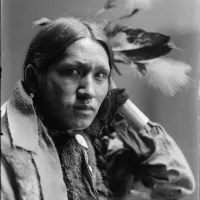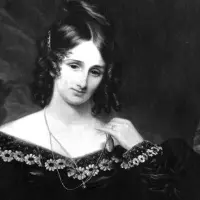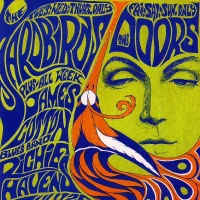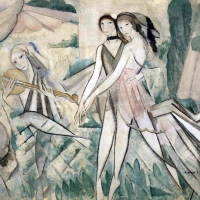 March
08
March
08
Tags
Anne Bonny, Eighteenth-Century Pirate Vixen
 On the 8th of March 1702, notorious Irish female pirate Anne Bonny was born as Anne Cormac, in Kinsale County Cork, the daughter of a servant woman and her solicitor employer. Trustworthy information about her life is scarce, mostly relying on A General History of the Pyrates. The book was written in 1724 and signed by a certain Charles Johnson, the alias of either Daniel Defoe or Nathaniel Mist. Anne’s story is entwined with that of an English pirate girl known as Mary Read. “The odd incidents of their lives are such, that some may be tempted to think the whole story no better than a novel or romance, but since it is supported by many thousand witnesses, I mean the people of Jamaica who were present at their trials and heard the story of their lives, upon the first discovery of their sex, the truth of it can be no more contested than that there were such men in the world as Roberts and Blackbeard, who were pirates.” (A General History of the Pyrates).
On the 8th of March 1702, notorious Irish female pirate Anne Bonny was born as Anne Cormac, in Kinsale County Cork, the daughter of a servant woman and her solicitor employer. Trustworthy information about her life is scarce, mostly relying on A General History of the Pyrates. The book was written in 1724 and signed by a certain Charles Johnson, the alias of either Daniel Defoe or Nathaniel Mist. Anne’s story is entwined with that of an English pirate girl known as Mary Read. “The odd incidents of their lives are such, that some may be tempted to think the whole story no better than a novel or romance, but since it is supported by many thousand witnesses, I mean the people of Jamaica who were present at their trials and heard the story of their lives, upon the first discovery of their sex, the truth of it can be no more contested than that there were such men in the world as Roberts and Blackbeard, who were pirates.” (A General History of the Pyrates).
From this book we know of the legend of Anne, whose family emigrated from Ireland to South Carolina, when she was a young girl. Losing her mother at an early age, her wealthy father supported her until she married a small-time pirate. Not entirely happy with his daughter’s choice of the husband the father disowned her. A fiery redhead with a temper to match, Anne was believed to have set her father’s plantation on fire, then left her weak-willed husband, who had become an informant in order to obtain the King’s pardon for pirates. Disguising herself in man’s clothes, she began sailing on the Vanity with its Captain Jack Rackham, whom she fell in love with. They preyed on Spanish treasure ships off Cuba and the Greater Antilles. Allegedly, she became pregnant by Jack and only retired long enough to give birth in Cuba, abandoning her child there. As the ship of the fellow English cross-dressing pirate girl Mary Read was overtaken by Rackham’s Vanity, Anne and Mary quickly discovered each other’s secret gender bond and became close friends.
 “The girls became known for their violent tempers and ferocious fighting, and they shared a reputation as “fierce hell cats.” Their fellow crewmembers knew that — in times of action — no one else was as ruthless and bloodthirsty as these two women were. One incident reported that as their ship was attacked, the drunken male pirates quickly hid below deck, leaving only Anne and Mary to defend their ship. The women yelled at their pirate mates to “come up, you cowards, and fight like men,” and then angrily raged against them, killing one and wounding several others. But the women were eventually overwhelmed by the British Navy, and the entire crew was captured and taken to Jamaica to stand trial. Captain Jack and the male members of his crew were tried on November 16, 1720, and were sentenced to hang. Anne was allowed to visit her lover in his cell before his execution, and instead of the consoling, loving words he was undoubtedly expecting, her scathing comments live on throughout history: “Had you fought like a man, you need not have been hang’d like a dog.” Anne and Mary were tried one week after Rackham’s death and were also found guilty. But at their sentencing, when asked by the judge if they had anything to say, they replied, “Mi’lord, we plead our bellies.” Both were pregnant, and since British law forbade killing an unborn child, their sentences were stayed temporarily. Mary is said to have died of a violent fever in the Spanish Town prison in 1721, before the birth of her child. Other reports say she feigned death and was sneaked out of the prison under a shroud. No record of Anne’s execution has ever been found. Some say that her wealthy father bought her release after the birth of her child and she settled down to a quiet family life on a small Caribbean island. Others believe that she lived out her life in the south of England, owning a tavern where she regaled the locals with tales of her exploits. And yet others say Anne and Mary moved to Louisiana where they raised their children together and were friends to the ends of their lives.”
“The girls became known for their violent tempers and ferocious fighting, and they shared a reputation as “fierce hell cats.” Their fellow crewmembers knew that — in times of action — no one else was as ruthless and bloodthirsty as these two women were. One incident reported that as their ship was attacked, the drunken male pirates quickly hid below deck, leaving only Anne and Mary to defend their ship. The women yelled at their pirate mates to “come up, you cowards, and fight like men,” and then angrily raged against them, killing one and wounding several others. But the women were eventually overwhelmed by the British Navy, and the entire crew was captured and taken to Jamaica to stand trial. Captain Jack and the male members of his crew were tried on November 16, 1720, and were sentenced to hang. Anne was allowed to visit her lover in his cell before his execution, and instead of the consoling, loving words he was undoubtedly expecting, her scathing comments live on throughout history: “Had you fought like a man, you need not have been hang’d like a dog.” Anne and Mary were tried one week after Rackham’s death and were also found guilty. But at their sentencing, when asked by the judge if they had anything to say, they replied, “Mi’lord, we plead our bellies.” Both were pregnant, and since British law forbade killing an unborn child, their sentences were stayed temporarily. Mary is said to have died of a violent fever in the Spanish Town prison in 1721, before the birth of her child. Other reports say she feigned death and was sneaked out of the prison under a shroud. No record of Anne’s execution has ever been found. Some say that her wealthy father bought her release after the birth of her child and she settled down to a quiet family life on a small Caribbean island. Others believe that she lived out her life in the south of England, owning a tavern where she regaled the locals with tales of her exploits. And yet others say Anne and Mary moved to Louisiana where they raised their children together and were friends to the ends of their lives.”
Both Mary and Anne were, for different reasons, forced to adopt male guises throughout their lives. Meanwhile, they were constantly threatened with the “reality” of their sex, facing up the truth that after all women are ruled by Love or Venus. Hence, it is not unexpected that Defoe positions them as female heroines on the stage of Jack Rackham’s sloop, proving themselves for their Captain’s attention and affection. Defoe loaded the term “loyalty” with ‘feminine’ connotations, related to sentimental motives, in a bid to keep Mary and Anne apart from the more raw and manly loyalties of piracy. On the other hand, when they are depicted in action, their aggressiveness is almost portrayed as unnaturally vile. The stories about them are told from a male perspective and it is true that the “action man ethos of shipwreck archaeology, maritime archaeology remains entrenched in the Western, androcentric, dualistic, heteronormative paradigm. Just as boat-building, sailing, fishing, trading, exploring and colonizing are prescribed as male activities,maritime archaeology remains masculine in its approach, techniques and interpretation. (…) Female pirates of the seventeenth and eighteenth century, women such as Anne Bonny and Mary Read, were mythologized. Their lives became famous popular stories. However, anomalies are particularly telling and the discourse surrounding these women points clearly to the way things ‘ought’ to be. Their narratives are of the deviant, the wanton. Their stories de-feminize them and recount masculine qualities. Their portrayal is of savagery, violence, the wild and untamed, the lost. Modern discourse may have sanitized this a little, presenting headstrong, lusty wenches, but it continues to fetishize them, adding undertones of supposed sexual deviance.” (Jesse Ransley, ‘Boats Are for Boys: Queering Maritime Archaeology’, World Archaeology, Vol. 37, No. 4, Debates in “World Archaeology”, Dec., 2005). A very interesting collection of gender focused essays on the subject can be found in Creighton and Norling’s Iron Men, Wooden Women. Gender and Seafaring in the Atlantic World, 1700-1920
Female pirates of the seventeenth and eighteenth century, women such as Anne Bonny and Mary Read, were mythologized. Their lives became famous popular stories. However, anomalies are particularly telling and the discourse surrounding these women points clearly to the way things ‘ought’ to be. Their narratives are of the deviant, the wanton. Their stories de-feminize them and recount masculine qualities. Their portrayal is of savagery, violence, the wild and untamed, the lost. Modern discourse may have sanitized this a little, presenting headstrong, lusty wenches, but it continues to fetishize them, adding undertones of supposed sexual deviance.” (Jesse Ransley, ‘Boats Are for Boys: Queering Maritime Archaeology’, World Archaeology, Vol. 37, No. 4, Debates in “World Archaeology”, Dec., 2005). A very interesting collection of gender focused essays on the subject can be found in Creighton and Norling’s Iron Men, Wooden Women. Gender and Seafaring in the Atlantic World, 1700-1920










I always find that when choosing between fact and fancy, it is the factual that never disappoints. These wonderful stories seem at times to straddle both, but they have a touch of reality to them, making contemplating them rather marvelous!
LikeLike
Pingback: Anne Bonny, Eighteenth-Century Pirate Vixen | A R T L▼R K | First Night History
I have a copy of James Nelson’s book. An excellent read.
LikeLiked by 1 person
Agreed. I’ve had a copy for years and it is a brilliant book.
LikeLike
Reblogged this on First Night History.
LikeLike
One of our contributors wrote about this recently:
https://wuhstry.wordpress.com/2015/02/21/the-bulldagger-of-the-harlem-rennaissance-the-gay-emperor-the-bisexual-pirate-and-the-blonde-bombshell/
So we are sharing this – very nice!
LikeLike
Pingback: Anne Bonny, Eighteenth-Century Pirate Vixen | A R T L▼R K | First Night History
Thank you for this post…will certainly be looking to purhcase the books mentioned as I am fascinated by the stories of these two individuals.
LikeLike